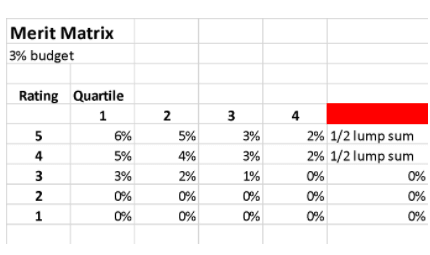 It’s merit increase time again. “How hard can doling out dollars be?”, you think. The budget is 3%, just give everyone on your team 3%, right? Well, maybe, but let’s talk about a better way to evaluate and incentivize your team members.
It’s merit increase time again. “How hard can doling out dollars be?”, you think. The budget is 3%, just give everyone on your team 3%, right? Well, maybe, but let’s talk about a better way to evaluate and incentivize your team members.
Compensation is a blend of a science and an art. Let’s talk about the science part first. Done correctly, there should be salary ranges for your organization and sometimes multiple sets of salary ranges, depending on the physical locations in which you operate. These salary ranges should have been created by knowing your overall target market percentiles and the value of each job that you are slotting into your ranges in the market. It is often helpful to create a matrix for your managers to use when considering merit increases. The performance rating should be on one axis and the quartile position in the salary range on the other axis. Keep in mind that the matrix is usually only a guideline.
As employees move through their salary range, their salary growth should slow. Someone who is performing at a 4 level, fully competent in their position, and in the 1st quartile, should receive a greater percentage increase than someone who is performing at the same level but is already in the 4th quartile. Don’t be afraid to be open about this with your subordinates. Compensation should not be a mystery. Employees have a right to understand how their merit increase was calculated. This can also open the door for conversations about career growth and additional responsibilities they could take on to move to the next salary grade.
Aside from merit increases, there are usually two additional types of increases that can happen. One is a promotion, which is simple enough. Someone is moving into a different position in a higher salary grade or is moving to a more senior position within their same job family. The second type of increase is the market adjustment. Perhaps the most misunderstood type of increase. A market adjustment is not a way to give your employees more money without going over your merit budget, as many new managers believe. A market adjustment is specifically used for an employee who is performing competently in their position, but is very low in their range. Many organizations will restrict market adjustments to employees who are performing at a level 4 or 5 and are in the first quartile of their salary range. This increase, in addition to the merit increase should bring the employee to the 2nd quartile or as high as the midpoint of the salary range.
The last topic is a merit increase that is called lump sum or one time merit increases. There are pros and cons of implementing lump sum increases.
These types of merit increase are reserved for employees performing at a level 4 or 5 and at the very top of their range. The theory is you are already paying these employees above the 100th percentile of the market and do not want to continue to increase their base salary. You do, however, want to continue to reward and incentivize them. If you decide to implement lump sums, they are usually given at about ½ the amount of a regular merit increase and paid all at one time at the beginning of the year.
So, now you know, doling out the dollars, can be a little more complicated than just giving everyone 3%, but, done correctly, you can continue to incentivize your best employees!
